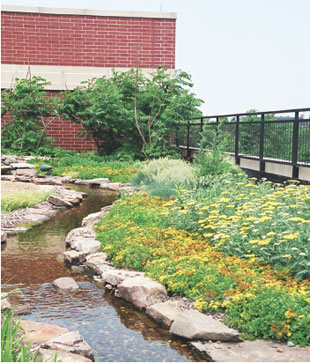
Green Roofs
By on Sep 07, 2007

by Laryssa Stolarskyj
What's next in the evolution of creating a more
healthy and beautiful city? Energy efficiencyand sustainable living are buzz phrases, and as
conscientious citizens-both individuals and businesses-we need to incorporate changes to existing structures and
lifestyles to do our part.
Green roofs are poised to be the newest development in
designing healthy cities. The concept may sound new to us, but green roofs have actually existed for over 5,000 years; thelightweight modern versions are rooted in the German
ecology movements of the 1960s and ?70s. Here in Toronto,Steven Peck is founder and president of Green Roofs for
Healthy Cities (GRHC), a network of public and privateorganizations formed in 1999 after a report was issued
outlining the benefits of green roofs. Today, it isa non-profit formal industry association promoting its
philosophy throughout North America about the economic,social, and environmental advantages of these structures.
A green roof is an extension of an existing roof and
consists of various additional layers that include waterproofing, root repellant, drainage, filter, growing medium,
and vegetation. Typically, a green roof has less than sixinches of growing medium and low plant diversity
maintained at minimal cost as opposed to a rooftop garden,which has greater than six inches of growing medium that
entails a higher cost and more plant diversity.
Peck enthuses about the benefits that green roofs have for
a city. "The big [benefits] are reduced energy consumption,
reduced urban heat island effect [1-2°C in Toronto from just5 per cent roof coverage], and retained stormwater, which
reduces beach closures, erosion management, and pollutionfrom combined sewer overflows. Green roofs also strip particulate
matter from the air, help to eliminate smog, and cancontribute, if they are planted right, to biodiversity conservation.
The York University green roof has four regionallyrare species of plants according to the Toronto and Region
Conservation Authority."The benefits are even more plentiful: they also reduce
greenhouse gases including carbon dioxide, improve airquality, insulate sound, extend the life of the roof by up to
twice as long, save on heating and cooling costs, provide asource of food production, create a habitat for birds, add
aesthetic appeal, increase the property value of homes, andcan even improve employee productivity.
Mike Mulqueen is an assistant planner for The City of
Toronto's City Planning Division. He says that 77 green
roofs exist in their inventory: 52 private and 25 publicpractitioners, including projects at 215 Spadina Avenue and
Mountain Equipment Co-op on King Street West.
He also
highlights the Green Roof Incentive Pilot Program, which
is designed to give "eligible property owners a grant of $10per square metre of acceptable green roof area to a maximum
grant amount of $20,000 as an incentive to install a greenroof?The program will be open to all owners of private
property in the City of Toronto irrespective of building sizeand type so long as the building is capable of supporting a
green roof that meets the program's requirements."Talks arecurrently underway for Toronto Hydro and the Toronto
Atmospheric Fund to contribute to the project.
If you're interested in growing your own residential green
roof, some important requirements to consider are your
roof 's structural loading capacity, its slope, the existingmaterials, drainage systems, and exposure to the elements.
Contact a green roof manufacturer to find out aboutlandscape architects and qualified roofing contractors who
can professionally install a green roof for you.
The Annual International Greening Rooftops for
Sustainable Communities Conference is taking place in
Boston this May.Visit www.greenroofs.org to learn more or seethe City of Toronto's website at www.toronto.ca/greenroofs.


